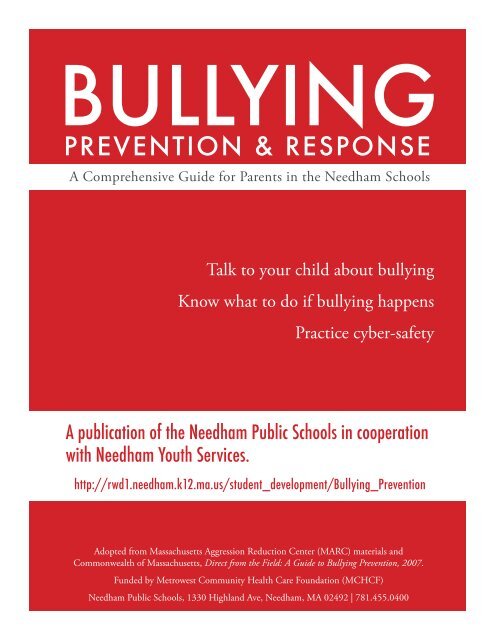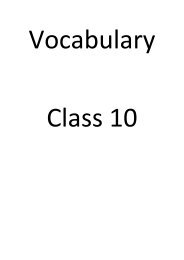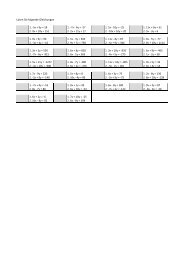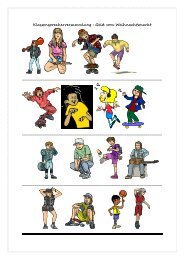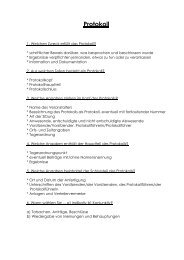Bullying Brochure_FINAL2013
Create successful ePaper yourself
Turn your PDF publications into a flip-book with our unique Google optimized e-Paper software.
BULLYING<br />
PREVENTION & RESPONSE<br />
A Comprehensive Guide for Parents in the Needham Schools<br />
Talk to your child about bullying<br />
Know what to do if bullying happens<br />
Practice cyber-safety<br />
A publication of the Needham Public Schools in cooperation<br />
with Needham Youth Services.<br />
http://rwd1.needham.k12.ma.us/student_development/<strong>Bullying</strong>_Prevention<br />
Adopted from Massachusetts Aggression Reduction Center (MARC) materials and<br />
Commonwealth of Massachusetts, Direct from the Field: A Guide to <strong>Bullying</strong> Prevention, 2007.<br />
Funded by Metrowest Community Health Care Foundation (MCHCF)<br />
Needham Public Schools, 1330 Highland Ave, Needham, MA 02492 | 781.455.0400
WHAT IS BULLYING?<br />
<strong>Bullying</strong> among children is aggressive behavior that is intentional and that involves an<br />
imbalance of power or strength. Typically, bullying happens over and over, it is unfair, onesided,<br />
cruel, and creates anxiety or fear. <strong>Bullying</strong> is not conflict among friends or rough play.<br />
WHY DOES BULLYING HAPPEN?<br />
<br />
Four helpful markers:<br />
imbalance of power between the target and aggressor<br />
intent to harm<br />
threat of further aggression<br />
creation of an atmosphere of terror<br />
(Coloroso, 2009)<br />
nasty pictures, or use someone else’s user name to spread rumors or lies.<br />
<strong>Bullying</strong> happens for many reasons – some aggressors<br />
see it as a way to be popular or to look tough, some<br />
do it to get attention or to play out jealousies, or<br />
others may be bullied themselves. Some people think<br />
that bullying is a part of growing up, just “kids being<br />
kids” or something children should work out among<br />
themselves. Research indicates that bullying has<br />
negative consequences for all children – the aggressors,<br />
the targets and the bystanders. And for some children<br />
bullying can lead to emotional distress, such as anxiety<br />
and depression, poor social skill development, and poor<br />
school performance.<br />
<strong>Bullying</strong> can also happen online or electronically.<br />
Known as cyberbullying, typically the Internet or<br />
mobile phones are used to send mean messages, post<br />
WHY DOES EVERY PARENT NEED TO GET INVOLVED?<br />
When bullying takes place, it affects the entire school community. Taunting, exclusion, and other acts of aggression contaminate the school<br />
environment. It’s vital that bullying prevention and intervention efforts involve not merely the individual aggressors and targets, but the<br />
school community as a whole.<br />
CURRENT RATES OF SELF -REPORTED BULLYING<br />
AMONG NEEDHAM STUDENTS<br />
Almost one in three students has experienced bullying, according to student self-reporting. In addition, one in<br />
<br />
The 2012 Metrowest Adolescent Health Survey provides information about 16 school districts and how they are doing in response<br />
to student bullying incidents. Compared to 2010, Needham students reported a decreased incidence of bullying victimization and<br />
perpetration. The incidence of cyberbullying, however remained steady at the high school and increased at the middle school. The Survey<br />
defines bullying behaviors as “being repeatedly teased, threatened, hit, kicked or excluded by another student or group of students”.<br />
Needham<br />
MS 2010<br />
Needham<br />
MS 2012<br />
Metrowest<br />
MS<br />
AVE 2012<br />
Needham<br />
HS 2010<br />
Needham<br />
HS 2012<br />
Metrowest<br />
HS<br />
AVE 2012<br />
Been Bullied 30% 22% 32% 28% 20% 27%<br />
Bullied someone else 17% 5% 12% 22% 11% 16%<br />
Been bullied on<br />
school property<br />
Been bullied using<br />
electronic media<br />
24% 17% 27% 24% 16% 23%<br />
12% 15% 17% 18% 16% 22%
WHAT SHOULD I DO TO PREVENT BULLYING?<br />
Talk to your child about bullying, even if it is not a problem now.<br />
Tell your child how you want him to behave. Be firm, clear, and consistent. For example, “In our family it’s never okay to bully or<br />
just stand by and watch others being bullied. <strong>Bullying</strong> is wrong. If you find yourself bullying others, please let us know so we can<br />
help you change your behavior.”<br />
Follow through with consequences if you find out your child bullied.<br />
Teach your child to be a helpful bystander. Research shows that kids who witness bullying feel powerless and seldom intervene.<br />
Yet, intervening can make a big difference in helping the situation and empowering the bystander.<br />
Practice answers to bullying behavior. It’s not easy for kids to respond to bullying so come up with some behaviors and lines such<br />
as “That’s bullying. Stop!” Encourage your child to avoid giving attention to the aggressor, and then tell an adult.<br />
Model respectful behavior.<br />
Help your child make friends. If your child doesn’t seem to have any friends, encourage your child to join groups or teams to find<br />
children with similar interests.<br />
WHAT MIGHT INDICATE THAT MY CHILD<br />
IS ENGAGING IN BULLYING BEHAVIOR?<br />
Children who bully others often act as though it’s no big deal. They might say they didn’t mean to hurt anyone using phrases like “I was<br />
just kidding. She can’t take a joke”. There may also be a problem if your child:<br />
Talks about other children in a negative way such as “wimp, loser, or stupid,” or talks as though other children deserve what happens<br />
to them, such as “He asked for it.”<br />
Doesn’t seem to care about others’ feelings or behaves in a rough way towards others<br />
Shows defiance such as stating, “You can’t tell me what to do!”<br />
Is easily frustrated when she doesn’t get her own way<br />
Is accused of bullying or gets in trouble at school or elsewhere for fighting<br />
If you are contacted by your child’s school with concern that your child is bullying others, it’s important to take it seriously and make<br />
sure your child gets help if necessary. Children who frequently bully can go on to bully others as adults in their dating, family and<br />
work relationships.<br />
WHAT MIGHT INDICATE THAT MY CHILD IS A TARGET?<br />
Some kids will talk, others won’t. Look for these signs:<br />
Injuries, stomachaches, headaches, or problems sleeping<br />
Lost or broken belongings or requests for extra money<br />
Staying away from school activities or doing worse in school<br />
Not wanting to be in unstructured school spaces (bathroom, cafeteria, recess, bus)<br />
WHAT CAN I DO TO HELP MY CHILD IF I THINK HE/SHE MAY<br />
BE A TARGET?<br />
If your child is not willing to talk to you, find a trusted adult your child will talk to, such as a teacher, guidance counselor,<br />
coach, family friend or relative.<br />
Tell your child that this is not his fault, and that he did nothing wrong.<br />
Tell your child she has a right to feel emotionally and physically safe.<br />
Validate your child’s feelings: “That must really hurt. I remember how hard that was when I was your age.”<br />
Role-play ignoring the bully or walking away. Emphasize that your child should not retaliate or attempt to fight or hit the bully.<br />
With your child, make a list of adults in school he or she can go to for help.<br />
Arrange for your child to see friends outside of school, and plan fun activities with the family.<br />
Cyber-bullying peaks at 10th grade<br />
Notify someone at school. With the school you can make an action plan. Whether or not the bullying is happening on school<br />
property it’s helpful for the adults at your school to be aware of a difficult situation. It can be extremely distressing to everyone<br />
involved – the aggressor, the target and the bystanders – and can impact the learning environment at school.
WHAT PARENTS SHOULD KNOW ABOUT<br />
CYBER-BULLYING<br />
Studies have found that 30-60% of teens have been<br />
cyberbullied online, and 85-90% of those have not<br />
told their parents. (MARC)<br />
Cyberbullying is repeated, electronic-based bullying via<br />
computers or cell phones. It usually involves abusive or cruel<br />
messages, comments, or images posted on Web sites or online<br />
profiles that are derogatory or even threatening. Even if children<br />
are not “typical” bullies it is possible for them to become involved<br />
in cyberbullying as a target or an aggressor. MARC research shows<br />
that the most common motives for cyberbullying are anger and the<br />
belief that cyberbullying is a “joke.” Gender differences show up online; girls tend to play out their anger and emotions, often “turning” on<br />
friends, while boys are more likely to taunt to get a laugh or look “cool.”<br />
In 2010, approximately 12% of Needham middle<br />
school students report having been bulled via<br />
electronic media.<br />
Your child’s cell phone may in reality be a hand held computer<br />
that occasionally makes phone calls. Mostly it’s a device for<br />
Facebook, texting, taking photos, sexting, IMing, making videos,<br />
surfing the web and You Tube, and more. It can also be a GPS<br />
making it possible for a stranger to locate their position. (Check<br />
the phone’s settings.) It can turn the web into a weapon, at<br />
any moment, in any location, with one simple send. Our kids<br />
understand technology, but not the impact it can have on others; parents understand the impact, but not the technology. Working together,<br />
families can make smart decisions.<br />
WHAT SHOULD I DO TO PREVENT CYBER-BULLYING?<br />
Coach your kids to think, think, think before hitting send on all electronic messages. Help them understand the consequences of<br />
their actions.<br />
Parent, guide, and coach kids around the power of technology. Be aware of what your child is saying and doing online. Let your child<br />
know you are monitoring their online activity. Avoid taking the technology away completely since most likely they will find a technology<br />
outlet some other way; instead help kids learn from their mistakes, set limits, and be responsible technology users.<br />
<br />
MARC has posted 5 easy steps at “Avoiding and Responding to Problems on Facebook”<br />
http://webhost.bridgew.edu/marc/parpub.html<br />
With your child, make and enforce cell phone and computer rules. Consider asking your child to deposit his/her cell phone in a<br />
basket at a reasonable hour so it does not distract from homework or sleep. With your child, decide what the consequences will be if<br />
rules are broken.<br />
Put off Facebook until your child is at least 14, the legal age under Facebook’s “Terms of Use.” Developmentally, kids under 14 aren’t<br />
ready for the content and/or consequences that often come with Facebook.<br />
Spend time together as a family. It’s the balancing counterpoint to the social frenzy.<br />
The Internet is a PERMANENT WRITTEN RECORD and can be more permanent than publishing an article in a<br />
newspaper. Postings can be forwarded, re-posted, blogged, listed anywhere, a million times over – even after<br />
the original posting has been deleted. Facebook and Google now archive everything. Often you are consenting<br />
to the sharing of information that you may believe is private when you agree to the “terms and conditions.”
WHAT SHOULD I TELL MY CHILD ABOUT CYBER-BULLYING?<br />
The Internet counts. If it’s illegal in person, it’s illegal online. This includes threats, stalking, and harassment. Joking is not an excuse.<br />
If you wouldn’t want it on a billboard, don’t post it on the Internet.<br />
Nothing is private. Even a profile or Web page set to “private” is not truly private –nothing in an online social networking site is<br />
truly secure.<br />
Protect your personal information. This includes your name, photo, phone number, address, town, the name of a team you play<br />
on, etc. Avoid sensitive information too – such as posting embarrassing or dumb things you’ve said or done.<br />
Don’t let your emotions rule your typing. If you’re upset or mad, log off for awhile.<br />
Posing as someone else online could result in criminal charges. This can be interpreted as identity theft, a serious crime, and can<br />
include: posting a fake profile by using someone else’s name, photo, or identifying information (no matter what the content of that<br />
fake profile); using someone else’s name or username or password; using a very similar screen name, plus that person’s real name.<br />
Online friends are strangers no matter how long you’ve “known” them. It’s easy to pose as someone else online. Even if<br />
you’ve corresponded with people online, they are strangers. Never agree to meet them or call them. Tell your parents if they want<br />
to meet you.<br />
Sites such as MySpace, Facebook, or the latest online craze such as Formspring or Honesty Box can be fun, but can also<br />
be dangerous. Honor the age requirements for these sites. Monitor regularly. Let your children know there may be long-term<br />
consequences for postings such as school discipline, getting a job or into college. At least 25% of colleges regularly check the online<br />
postings of prospective students.<br />
If someone cyberbullies you, never respond. Save the message. Tell an adult. If physical threats or violence are part of the message,<br />
call the police.<br />
<br />
PROCEDURES<br />
HOW SHOULD I REPORT A BULLYING INCIDENT THAT TAKES PLACE<br />
AT SCHOOL?<br />
The district expects students, parents/guardians, staff, and others who witness or become aware of an instance of bullying or retaliation to<br />
report it to the school principal or designee without delay.<br />
<br />
www.rwd1.needham.k12.ma.us/student_development/<strong>Bullying</strong>_Prevention<br />
It is helpful to report: what specifically happened, who committed the alleged acts, who was present or may have information about the<br />
events, where and when (date, time) the events occurred. The report may be made anonymously, however no disciplinary action may be<br />
taken against a student solely on the basis of an anonymous report. A student who knowingly makes a false accusation of bullying or<br />
retaliation will be subject to disciplinary action.<br />
HOW WILL THE SCHOOL RESPOND?<br />
The school will investigate all reports, giving consideration to the circumstances, including the nature of the allegations and the ages of<br />
the students involved. Upon determining that bullying or retaliation has occurred, a disciplinary response and an educational response<br />
will be determined for the aggressor. The needs of the target will be evaluated, and the safety and support for the target will be a priority<br />
of the school’s principal. The school will notify the parent/guardian of both the target and aggressor, and the school’s procedures for<br />
responding to it. This notice will indicate what action is being taken to prevent any further acts of bullying or retaliation. If the school<br />
principal has a reasonable basis to believe that the incident may involve criminal conduct, the principal or designee will notify the local law<br />
enforcement agency.<br />
Specific information about disciplinary action taken will not be released to the target’s parents or guardians, unless it involves a “stay away”<br />
order or other directive that the target must be aware of in order to report violations. Schools are limited in how much information can be<br />
shared; parents of targets often want to know what punishment the aggressor received. FERPA privacy laws prevent the school from sharing<br />
that information. For more on school’s responsibilities under FERPA go to www.marccenter.org and click on “Why Is It Confidential?”
RESOURCES AVAILABLE TO TARGETS, AGGRESSORS<br />
The Guidance staff at each school is responsible for identifying the resources and services needed by targets, aggressors, and their families,<br />
and for making referrals for those services. Services may include counseling provided by the guidance staff, and/or resources and services<br />
available in the community such as Needham Youth Services and Riverside Community Care. Project Interface, a local mental health<br />
referral service is also accessible by guidance staff.<br />
After a bullying incident has been investigated and confirmed, the guidance counselor or the Principal’s designee will develop a school<br />
action plan to insure the emotional and physical safety of all students.<br />
The action plan, developed in collaboration with the target, and shared with his/her parents or guardians, will specify the following:<br />
A trusted adult in the school who will be available to the target as needed<br />
If needed, a “script” that the target will follow whenever he/she feels intimidated or “at risk” from the aggressor for continued<br />
bullying or retaliation<br />
A description of the level of supervision to be provided during identified periods of the day when the target desires protection<br />
Any other actions that the school will take to insure a safe school environment for the target<br />
STUDENTS WITH DISABILITIES<br />
As required by law, when the Individual Education Program (IEP) Team determines the student has a disability that affects social skills<br />
development or the student may participate in or is vulnerable to bullying, harassment, or teasing because of his/her disability, the Team will<br />
consider what should be included in the IEP to develop the student’s skills and proficiencies to avoid and respond to bullying, harassment,<br />
or teasing. The district has created documents that will guide the discussion of each student’s needs in regards to social skills development at<br />
the IEP Team meeting.<br />
NEEDHAM’S BULLYING POLICY AND STUDENT HANDBOOKS<br />
Guidelines for conduct have been written for inclusion in Student Handbooks beginning September 2011. All<br />
<br />
<br />
available at the district <strong>Bullying</strong> Prevention website:<br />
http://rwd1.needham.k12.ma.us/student_development/<strong>Bullying</strong>_Prevention<br />
NON-DISCRIMINATION POLICY<br />
It is the policy of Needham Public Schools not to discriminate on the basis of race, gender, religion, national origin, color, homelessness,<br />
sexual orientation, age or disability in its education programs, services, activities or employment activities.
SOCIAL/EMOTIONAL LEARNING PROGRAM<br />
At the Needham Schools we believe that social/emotional learning (SEL) provides the<br />
foundation for effective bullying prevention. Needham’s SEL program focuses on teaching<br />
kids not just about topics like bullying, but skills for learning, working and playing with<br />
others that can be applied in high stakes situations such as bullying.<br />
Skill Competencies<br />
Skill competencies are defined in three areas:<br />
Decision-making<br />
Self-management<br />
Interpersonal/communication skills<br />
Learning & Applying Skills<br />
Implementation of the program focuses on three key components:<br />
Teaching skills<br />
Creating the structures and routines that allow students<br />
to practice those skills<br />
Creating a school culture that is conducive to positive social<br />
interactions<br />
More about SEL at: http://rwd1.needham.k12.ma.us/student_development/<br />
BULLYING PREVENTION LESSONS WITHIN THE SEL PROGRAM<br />
Specific bullying prevention curriculum is layered within Needham’s SEL program. Anchor programs at each level include:<br />
Preschool: Smart Start<br />
Elementary: Second Step for skill-building; Steps to Respect for bullying prevention; Responsive Classroom for practices/routines/<br />
classroom culture<br />
Middle: Advisory (20 minutes per day in groups of around 14 students with an advisor); <strong>Bullying</strong> prevention curriculum;<br />
Health curriculum<br />
High: Mentor Homeroom (10 minutes per day); Positive Coaching Alliance for athletics; Health curriculum<br />
ABOUT SECOND STEP AND STEPS TO RESPECT<br />
Second Step provides direct instruction in social skills aimed at reducing impulsive and aggressive behavior while increasing social<br />
competence. Through 20-25 lessons per grade level, role-plays, picture cards or videos of children in everyday social situations are used<br />
to teach children to:<br />
identify and understand their own and others’ emotions,<br />
reduce impulsiveness and choose positive goals, and<br />
manage their emotional reactions and decision-making process when emotionally aroused.<br />
In Kindergarten-4th grades, Second Step is supplemented by specific bullying lessons. In 5th grade, Second Step is replaced or augmented<br />
by its sister bullying prevention program called Steps to Respect. It teaches students to recognize, refuse, and report bullying, be assertive,<br />
and build friendships. Go to www.cfchildren.org for more information. A sample lesson on bystander involvement may be downloaded at:<br />
http://www.cfchildren.org/media/files/str%5Fms%5Flesson.pdf
RESOURCES<br />
NEEDHAM PUBLIC SCHOOLS BULLYING<br />
PREVENTION INFORMATION<br />
http://rwd1.needham.k12.ma.us/student_development/<strong>Bullying</strong>_Prevention<br />
NEEDHAM YOUTH SERVICES<br />
NYS is a mental health resource providing professional and confidential clinical and programmatic services. Services include support,<br />
information, and direction to youth and families on issues such as family, social, peer, stress, loss, alcohol, drug, and other<br />
youth-related concerns<br />
www.needhamma.gov/youth<br />
MASSACHUSETTS GUIDE TO BULLYING PREVENTION<br />
The guide is a 123 page easy-to-read comprehensive source for a wide range of information for parents and schools.<br />
www.mass.gov/Eeohhs2/docs/dph/com_health/violence/bullying_prevent_guide.pdf<br />
OTHER HELPFUL WEBSITES:<br />
www.MARCcenter.org<br />
www.safeyouth.org<br />
www.kidshealth.org<br />
www.stopbullynow.hrsa.gov<br />
www.familyinternet.about.com<br />
www.pacerkidsagainstbullying.org<br />
http://www.preventbullying.org/problem.html<br />
WEBSITES FOCUSED ON TECHNOLOGY:<br />
www.onguardonline.gov/topics/net-cetera.aspx<br />
www.ikeepsafe.org/PRC/<br />
www.connectsafely.org<br />
www.netsmartz.org<br />
www.getnetwise.org<br />
www.staysafeonline.org<br />
www.cyberbully411.org<br />
www.netfamilynews.org<br />
In 2010 Massachusetts adopted M.G.L. c. 71, section 370, a bullying prevention and intervention law.<br />
The new law requires school districts to develop and adopt bullying prevention and intervention plans.<br />
This parent guidebook is intended to inform parents about bullying and engage parents in our bullying prevention efforts.


